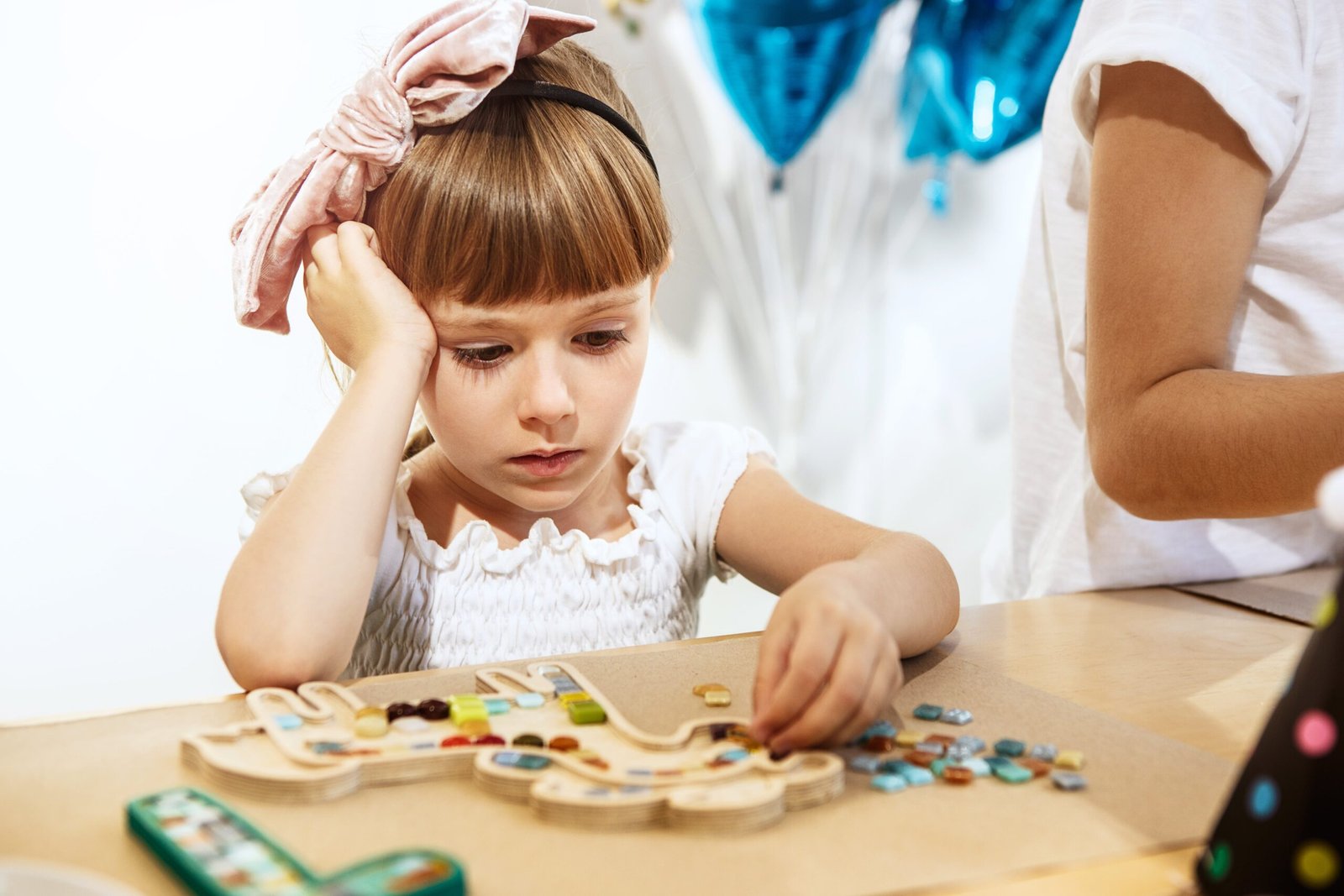In the dynamic realm of preschool education, optimizing the potential of young minds involves recognizing the significance of Brain Break Activities for Preschoolers. These intentional breaks in routine offer more than just a pause in the day; they are strategic interludes designed to recharge, refocus, and rejuvenate developing brains. By incorporating short, engaging activities such as simple stretches, music, movement, or brief mindfulness exercises, educators can effectively enhance cognitive functions and promote overall well-being.
These brain breaks serve as a means to energize little bodies and as valuable tools to foster concentration, attention, and emotional regulation. Making the most of these intentional breaks is not just about physical activity; it’s about nurturing preschoolers’ cognitive and emotional development and creating a balanced and supportive learning environment that maximizes their growth potential.
Understanding the Importance: Brain Break Activities for Preschoolers
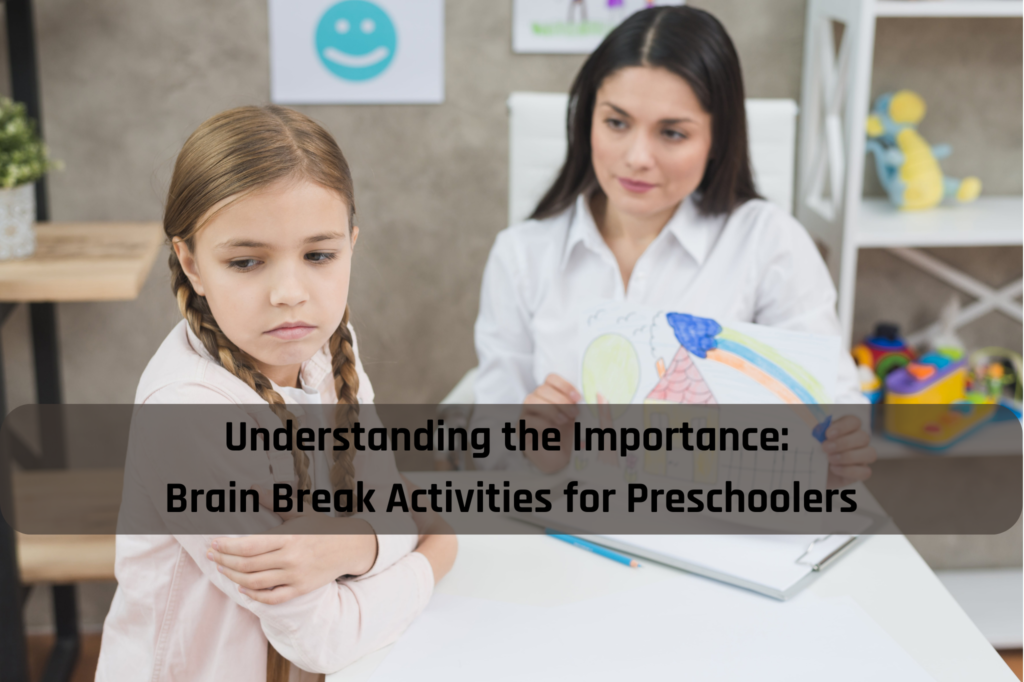
Preschoolers are energetic bundles of joy constantly exploring and learning. Their brains are rapidly developing, absorbing information like sponges. However, young children also have limited attention spans and require frequent breaks to maintain focus and engagement. This is where Brain Break Activities for Preschoolers come into play.
Why Brain Breaks Matter?
Brain breaks are short, active intervals incorporated into learning sessions to provide children with physical and mental stimulation. Engaging in these activities offers numerous benefits:
- Improved focus and concentration: When children engage in physical activity, their brains release endorphins, chemicals that boost energy levels and improve cognitive function. This enhanced focus allows them to return to their learning tasks with renewed enthusiasm and retain information more effectively.
- Reduced stress and anxiety: Preschoolers often experience anxiety and stress from new environments, social interactions, and academic challenges. Brain breaks provide a healthy outlet for them to release pent-up energy, calm their minds, and return to their activities feeling refreshed and ready to learn.
- Enhanced motor skills and coordination: Many brain break activities involve physical movement, which helps children develop their gross and fine motor skills. This includes activities like jumping, dancing, and manipulating objects, all of which contribute to their overall physical development.
- Increased creativity and problem-solving skills: Some brain breaks involve creative tasks like drawing, building, or storytelling. These activities encourage children to think outside the box, explore their imaginations, and develop problem-solving skills.
- Improved social skills and interaction: Brain breaks can be done individually or in groups, promoting social interaction and cooperation. Children learn to take turns, follow instructions, work together, and build friendships during these engaging activities.
Types of Brain Break Activities for Preschoolers
There are numerous brain break activities to choose from, catering to different interests and learning styles. Here are a few examples:
- Movement and exercise: Jumping jacks, dancing to music, obstacle courses, animal walks, yoga poses, stretches, and playing with balls are all great ways to get children moving and their blood pumping.
- Sensory activities: Sensory bins filled with textures like playdough, rice, or beans can stimulate children’s senses and provide calming and engaging experiences.
- Creative activities: Coloring, drawing, painting, building with blocks, play dough creations, and musical instruments can spark children’s creativity and imagination.
- Mindfulness activities: Deep breathing exercises, guided meditations, and listening to calming music can help children focus their attention and find inner peace.
- Group games: Simon Says, Freeze Dance, Red Light Green Light, and Scavenger Hunts are fun and engaging activities that encourage social interaction and physical movement.
Implementing Brain Breaks
The key to successful brain breaks is incorporating them regularly into your learning sessions. Aim for short breaks every 15-20 minutes, especially during activities requiring sustained attention.
Here are some tips for implementing brain breaks effectively:
Choose activities that are age-appropriate and cater to the interests of your children. Variety is key to keeping them engaged and excited.
Make it fun and engaging. Use music, props, and storytelling to create a positive and enjoyable experience.
Keep it short and sweet. Aim for 5-10 minutes for brain breaks to maintain a positive impact on focus and concentration.
Get involved! Participate in the activities with the children to create a sense of community and shared enjoyment.
By incorporating Brain Break Activities for Preschoolers into your learning sessions, you can help children improve their focus, reduce stress, develop important skills, and foster a love of learning.
Designing Engaging Breaks: Crafting Brain Break Activities for Preschoolers
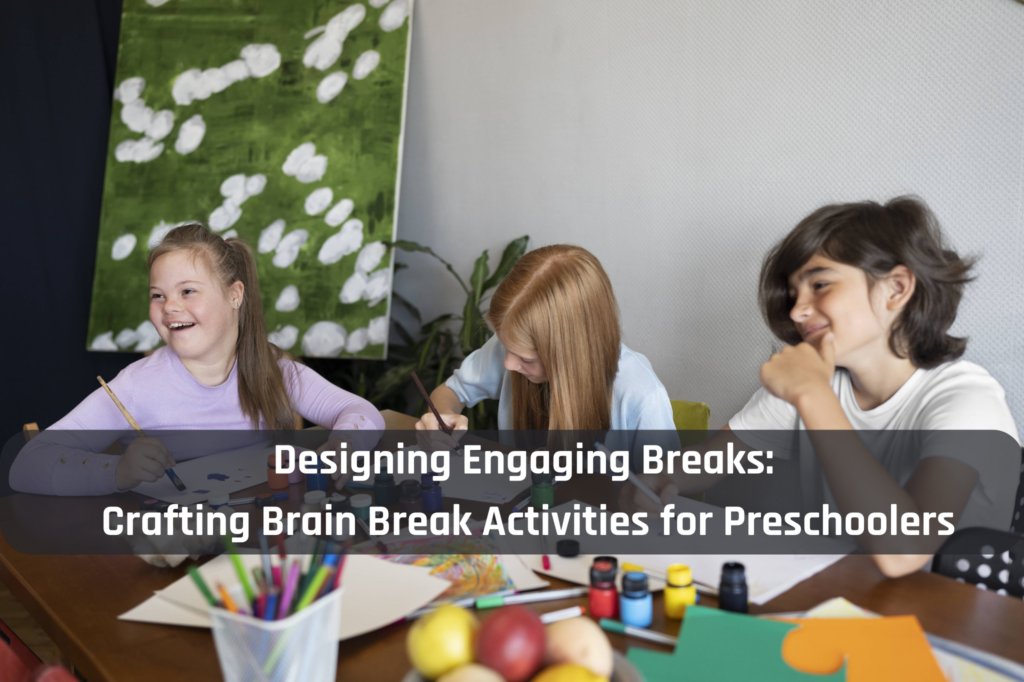
In the bustling world of a preschool, where energy levels are high and attention spans are short, Brain Break Activities for Preschoolers become lifesavers. These short bursts of activity, strategically placed throughout the day, help little minds recharge, refocus, and return to learning with renewed enthusiasm. But how do we design brain breaks that are not just engaging, but also beneficial for their development?
The Magic of Movement:
Preschoolers are wired for movement. Their bodies crave physical activity to release energy, enhance coordination, and boost brain function. Brain breaks that incorporate movement, like dancing to music, jumping jacks, or obstacle courses, are sure to be a hit. Adding props like scarves, balls, or hoops can inject an extra dose of fun and encourage creativity. Remember, the key is to keep it simple and energetic to maximize engagement.
Sensory Stimulations:
Engaging the senses is another powerful tool for crafting captivating brain breaks. Sensory bins filled with textured materials like rice, beans, or playdough provide opportunities for tactile exploration and calming sensory experiences. Adding scented objects or natural materials like leaves and twigs can further enhance the experience. For a visual treat, incorporate colorful scarves, bubbles, or light-up toys to stimulate the sense of sight.
Spark the Imagination:
Brain breaks can be more than just physical breaks; they can be opportunities to ignite creativity and imagination. Short bursts of storytelling, role-playing, or puppetry can transport children to different worlds and encourage self-expression. Provide simple props like costumes, scarves, or puppets to help them explore their characters and fuel their imaginations.
The Power of Play:
Preschoolers learn best through play. Incorporate familiar games like Simon Says, Freeze Dance, or Red Light Green Light into your brain breaks. These games encourage social interaction, physical movement, and listening skills, while also providing a healthy dose of fun and laughter.
The Calming Corner:
For some children, a quieter brain break might be the answer. Create a designated “calming corner” equipped with comfortable pillows, blankets, and calming toys. Encourage children to engage in deep breathing exercises, listen to soothing music, or simply relax and unwind. This quiet space allows them to recharge and return to learning feeling refreshed and calm.
The Importance of Variety:
Remember, variety is the spice of life! Don’t be afraid to experiment and try different brain-break activities to keep children engaged and excited. Incorporate seasonal themes, special events, or even children’s interests to create unique and personalized experiences.
Making it a Collaborative Effort:
Involve children in planning and choosing brain break activities. This fosters a sense of ownership and encourages them to take an active role in their learning.
Beyond the Break:
The benefits of brain breaks extend beyond the immediate moment. They can foster a positive learning environment, build community, and promote a healthy connection between mind and body. By designing engaging and beneficial brain breaks, we can help young learners reach their full potential and set them on a path of lifelong learning.
Energizing the Classroom: Implementing Effective Brain Break Activities for Preschoolers
The preschool classroom is a vibrant space brimming with energy and curiosity. But just like a car engine, young minds need regular breaks to prevent burnout and maintain optimal performance. That’s where Brain Break Activities for Preschoolers come in.
These short bursts of activity, strategically interspersed throughout the day, are not mere distractions; they are essential tools for:
Rejuvenating Attention: Preschoolers have limited attention spans. Engaging brain breaks helps them release pent-up energy, refocus their minds, and return to learning tasks with renewed enthusiasm.
Boosting Energy Levels: Physical activity during brain breaks increases blood flow and oxygen levels to the brain, leading to improved focus, concentration, and memory.
Developing Essential Skills: Many brain break activities incorporate movement, coordination, social interaction, and creative thinking, contributing to the holistic development of young children.
Creating Positive Associations: When learning is associated with fun and movement, it becomes a more enjoyable experience. This can foster a positive attitude towards school and encourage a lifelong love of learning.
But how do we implement brain breaks effectively in the classroom? Here are some key tips:
1. Keep it short and sweet. Aim for 5-10 minutes of activity to maximize engagement and avoid disrupting the flow of learning.
2. Incorporate variety. Offer a diverse range of activities, including movement, sensory exploration, creative play, and mindfulness exercises, to cater to different learning styles and interests.
3. Make it active. Encourage physical movement through dancing, jumping jacks, obstacle courses, or yoga poses to release energy and boost energy levels.
4. Embrace sensory experiences. Sensory bins filled with textures like playdough, rice, or beans can be calming and engaging for some children. Others might enjoy scented objects, light-up toys, or bubbles.
5. Spark creativity. Encourage children to use their imaginations through storytelling, role-playing, puppetry, or simple art Activities for Preschoolers. Provide props and materials to enhance the experience and foster self-expression.
6. Encourage collaboration. Group activities like Simon Says, Freeze Dance, or Red Light Green Light promote social interaction, physical movement, and listening skills.
7. Consider individual needs. Some children might prefer quieter activities, like listening to calming music or practicing deep breathing exercises. Create a designated “calming corner” for them to recharge and refocus.
8. Get involved! Participate in the activities with your students. This demonstrates your enthusiasm, builds rapport, and creates a more positive and engaging learning environment.
9. Rotate leadership. Regularly involve children in choosing and leading brain break activities. This fosters a sense of ownership and promotes active learning.
10. Track the impact. Observe how children respond to different activities and adjust your approach accordingly. Monitor their energy levels, focus, and overall engagement to ensure your brain breaks are delivering positive results.
By implementing effective Brain Break Activities for Preschoolers, we can create a classroom environment that is not only conducive to learning but also fosters a love for movement, creativity, and collaboration. Remember, these short bursts of activity are not just breaks; they are investments in the future success and well-being of our youngest learners.
Enhancing Concentration and Focus: The Cognitive Benefits of Brain Breaks for Preschoolers
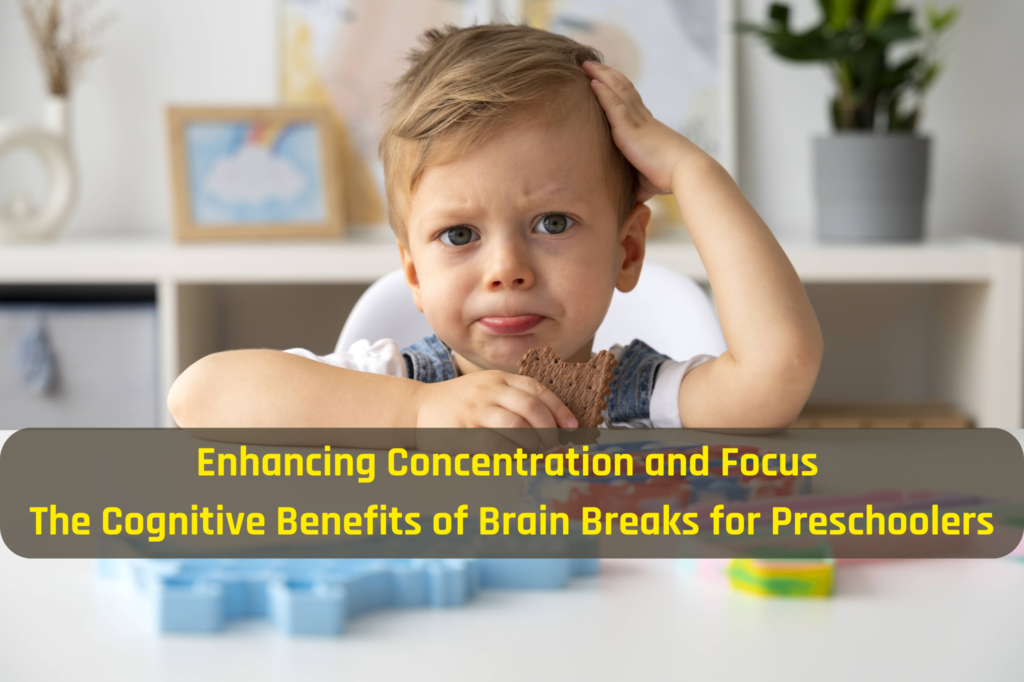
In a world where children are bombarded with information and stimuli, it can be challenging to maintain focus and concentration. This is especially true for preschoolers whose brains are still developing and learning to filter out distractions. Fortunately, there’s a simple yet powerful tool that can help young learners sharpen their focus and boost their cognitive abilities: Brain Break Activities for Preschoolers.
Beyond the physical benefits of movement and energy release, brain breaks offer a wealth of cognitive advantages:
1. Improved Attention Span: Engaging in short bursts of activity helps children refocus their attention and return to learning tasks with renewed enthusiasm. This is because physical activity increases blood flow and oxygen to the brain, enhancing cognitive function and alertness.
2. Enhanced Memory and Learning: Brain breaks can stimulate the release of endorphins, chemicals that improve memory consolidation and information retention. This means children are more likely to remember what they learn after a short break filled with movement or engaging activities.
3. Increased Problem-Solving Skills: Many brain-break activities, such as puzzles, games, and creative tasks, encourage critical thinking and problem-solving skills. By engaging in these activities, children learn to think creatively, analyze situations, and develop solutions to challenges.
4. Boosted Cognitive Flexibility: Shifting between different tasks and activities, as they do during brain breaks, helps children develop cognitive flexibility. This ability to adapt to changing demands is crucial for learning and success in various aspects of life.
5. Reduced Stress and Anxiety: The energetic nature of brain breaks provides a positive outlet for children to release stress and anxiety. This can lead to improved emotional regulation and a more relaxed and focused learning environment.
6. Enhanced Motivation and Engagement: When learning is interspersed with fun and engaging activities, children become more motivated and engaged in the learning process. This positive association with school can lead to a lifelong love of learning and a desire to explore new knowledge.
7. Improved Social-Emotional Skills: Group brain break activities, like collaborative games and role-playing, encourage social interaction and cooperation. This helps children develop communication skills, build relationships, and understand social cues.
8. Promoted Self-Regulation: Activities like deep breathing exercises and mindfulness practices teach children techniques for managing their emotions and regulating their behavior. This self-awareness empowers them to make positive choices and navigate challenging situations effectively.
9. Increased Creativity and Imagination: Creative brain breaks, such as storytelling, drawing, or building with blocks, stimulate children’s imaginations and encourage them to think outside the box. This helps develop their creativity and problem-solving skills, which are essential for success in various fields.
10. Enhanced Sensory Processing: Sensory-based brain breaks, like playing with textures or manipulating objects, help children develop their sensory processing skills. This sensory awareness improves their ability to learn and interact with their environment.
By incorporating Brain Break Activities for Preschoolers into the learning process, educators can unlock a treasure trove of cognitive benefits. From improved attention and memory to enhanced problem-solving skills and emotional regulation, these short bursts of activity can significantly impact children’s overall development and set them on a path to lifelong learning and success.
Mindful Moments: Incorporating Relaxation in Brain Break Activities for Preschoolers
In the whirlwind of a preschool day, where energy levels soar and excitement reigns supreme, it’s easy to overlook the importance of relaxation for young minds. While brain breaks offer a much-needed escape from structured learning, incorporating elements of mindfulness can elevate them from mere energy bursts to transformative experiences. By introducing Mindful Moments into Brain Break Activities for Preschoolers, we can help them cultivate inner peace, build self-awareness, and return to learning with renewed focus and clarity.
Why Mindfulness Matters:
Preschoolers are bombarded with sensory input and external stimuli, making it challenging for them to quiet their minds and regulate their emotions. Mindfulness practices, such as focusing on the breath or engaging in calming activities, can provide them with tools to manage stress, anxiety, and overwhelm. By incorporating these practices into brain breaks, we can:
- Promote Self-Awareness: Mindful moments encourage children to focus their attention on their internal state, including their thoughts, feelings, and bodily sensations. This increased self-awareness empowers them to understand their emotions and make conscious choices about their behavior.
- Enhance Emotional Regulation: Mindfulness practices can help children learn to regulate their emotions in healthy ways. Techniques like deep breathing and guided visualizations provide tools to calm their minds and manage difficult emotions like anger or frustration.
- Improve Focus and Concentration: When children practice mindfulness, they develop their ability to focus their attention and be present in the moment. This improved focus carries over into learning activities, allowing them to retain information more effectively and learn with greater concentration.
- Reduce Stress and Anxiety: The fast-paced nature of preschool life can be overwhelming for young children.
- Mindful moments offer a safe space for them to relax, release tension, and experience inner peace. This can lead to reduced stress and anxiety levels, improving their overall well-being.
- Foster Empathy and Compassion: By focusing on their feelings and sensations, children develop an awareness of their inner world. This awareness naturally translates into empathy and compassion for others, fostering positive social interactions and a sense of connection.
Integrating Mindfulness into Brain Breaks:
Here are some ways to incorporate mindful moments into brain breaks for preschoolers:
- Deep Breathing Exercises: Guide children through simple breathing exercises, focusing on the sensation of their breath entering and leaving their bodies.
- Body Scans: Encourage children to lie down or sit comfortably and gently scan their bodies, noticing sensations in different parts without judgment.
- Mindful Movement: Engage in activities like yoga poses, gentle stretches, or tai chi, emphasizing awareness of each movement and the connection between mind and body.
- Nature Walks: Take children outside for a short walk, encouraging them to focus on the sights, sounds, and smells of their surroundings.
- Mindful Listening Activities: Play calming music or nature sounds and encourage children to focus on the sounds they hear without judgment.
- Creative Visualization: Guide children through relaxing visualizations, imagining peaceful scenes or positive experiences.
- Sensory Exploration: Provide materials with different textures, scents, or sounds and encourage children to explore them using their senses.
Remember:
Keep it age-appropriate: Use simple language and activities that are easy for young children to understand and participate in.
Make it fun and engaging: Incorporate elements of play, storytelling, and imagination to create a positive and enjoyable experience.
Lead by example: Demonstrate mindfulness practices yourself and encourage children to follow along.
Start small: Begin with short mindful moments and gradually increase the duration as children become more comfortable with the practices.
By incorporating Mindful Moments into Brain Break Activities for Preschoolers, we can create a well-rounded learning environment that fosters not only cognitive development but also emotional well-being and self-awareness. These precious moments of calm can provide children with the tools they need to navigate the challenges of life with grace and resilience, setting them on a path to lifelong success and happiness.
Building Healthy Routines: Integrating Brain Break Activities for Preschoolers
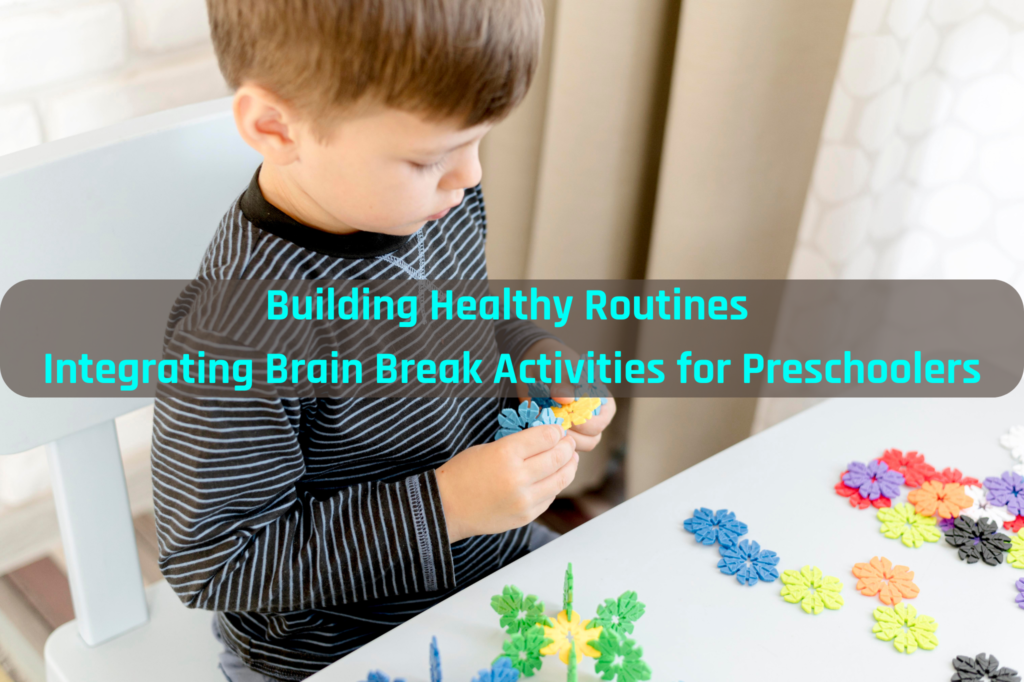
In the formative years of preschool, establishing healthy routines is crucial for fostering holistic development. While academic learning is important, incorporating Brain Break Activities for Preschoolers into a daily routine can unlock a range of benefits beyond cognitive growth. These short bursts of activity serve as essential tools for nurturing physical, social, emotional, and creative development, laying the foundation for a well-balanced and thriving individual.
Beyond the Academic:
While traditional learning activities focus on cognitive development, integrating brain breaks can address various aspects of a child’s well-being:
Physical Development: Movement-based brain breaks, like dancing, obstacle courses, or yoga, encourage physical activity, improve coordination, and develop gross and fine motor skills. This not only benefits their physical health but also enhances their energy levels and overall well-being.
Social-Emotional Development: Collaborative games, role-playing activities, and group movement exercises provide opportunities for children to interact, communicate, and build relationships. These interactions foster social skills, empathy, and emotional regulation, equipping them for successful social interactions throughout their lives.
Creative Development: Activities like storytelling, drawing, and building with blocks encourage children to explore their imaginations, think outside the box, and express themselves creatively. This fosters cognitive flexibility, problem-solving skills, and a love for self-expression, which are crucial for navigating a complex and ever-changing world.
Emotional Regulation: Sensory exploration activities, mindfulness practices, and deep breathing exercises provide children with tools to manage their emotions effectively. By learning to self-regulate, they gain the ability to cope with stress, calm themselves down, and maintain emotional well-being, fostering resilience and self-awareness.
Building a Well-Rounded Routine:
Integrating brain breaks into a daily routine can be simple and effective:
Plan and Schedule: Allocate specific times throughout the day for brain breaks, ensuring regular intervals of activity and relaxation.
Variety is Key: Offer a diverse range of activities to cater to different interests and learning styles, keeping children engaged and enthusiastic.
Short and Sweet: Aim for 5-10 minutes of activity for each break to maintain focus and avoid disrupting the flow of learning.
Active Participation: Encourage children to actively participate in the activities to maximize engagement and enjoyment.
Positive Reinforcement: Use positive reinforcement to encourage participation and create a fun and supportive learning environment.
Monitor and Adapt: Observe how children respond to different activities and adjust your approach accordingly to ensure their needs are met.
Embrace Collaboration: Involve children in choosing and planning brain break activities, fostering ownership and encouraging active participation.
Connect with Families: Share information about brain breaks with families, encouraging them to incorporate similar activities into their daily routines for continuity and reinforcement.
By integrating Brain Break Activities for Preschoolers into a well-rounded routine, we can nurture holistic development, foster a love for learning, and equip children with the essential skills they need to thrive in all aspects of life. Remember, it’s not just about academic success; it’s about creating a foundation for a happy, healthy, and well-balanced individual.
